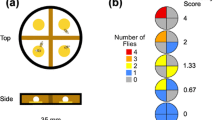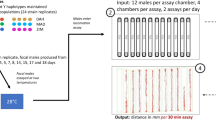Abstract
Tests for reproductive isolation between lines selected for locomotor activity were performed. Three sets of selection lines were used, each consisting of lines selected for low and high locomotor activity from the same base population. Females preferred high-activity males in almost every case. However, in one of the sets temporary sexual isolation was found between flies of the high and low lines. This was accompanied in the low-activity females with a higher fertility when they were mated with their own males. After further selection the partial isolation disappeared.
Similar content being viewed by others
References
Baptist, R., and Robertson, A. (1976). Asymmetrical responses to automatic selection for body size inDrosophila melanogaster.Theor. Appl. Genet.,47:209–213.
Burnet, B., and Connolly, K. (1975). Activity and sexual behaviour inDrosophila. InThe Genetics of Behaviour, North Holland, Amsterdam.
Del Solar, E. (1966). Sexual isolation caused by selection for and against positive and negative phototaxis and geotaxis inDrosophila pseudoobscura.Proc. Natl. Acad. Sci. 56:484–487.
Hardeland, R., and Stange, G., (1971). Einflüsse von Geslecht und Alter auf die lokomotorische Aktivität vonDrosophila.
Koref-Santibañez, S., and Waddington, C. H. (1958). The origin of sexual isolation between different lines within a species.Evolution 12:485–493.
Latter, B. D. H., and Robertson, A. (1962): The effects of inbreeding and artificial selection on reproductive fitness.Genet. Res. 3:110–138.
Malogolowkin-Cohen, C., Simmons, S., and Levene, H. (1965). A study of sexual isolation between certain strains ofDrosophila paulistorum.Evolution 19:95–103.
Manning, A. (1961). The effects of artificial selection for mating speed inDrosophila melanogaster.Anim. Behav. 9:82–92.
Muller, H. J. (1939). Reversibility in evolution considered from the standpoints of genetics.Biol. Rev. 14:261–280.
Robertson, F. W., and Reeve, E. C. R. (1955). Studies in quantitative inheritance. VII. Crosses between strains of different bodysize inD. melanogaster.Z. Indukt. Abst. Vererbungs lehre 86:439–458.
Sokal, R. R., and Rohlf, F. J. (1969).Biometry, Freeman, San Francisco.
van Dijken, F. R., and Scharloo, W. (1979). Divergent selection on locomotor activity inDrosophila melanogaster. I. Selection response.Behav. Genet.,9:543–553.
van Dijken, F. R., Stolwijk, H., and Scharloo, W. (1980). Locomotor activity inDrosophila. Neth. J. Zool. (in press).
Author information
Authors and Affiliations
Rights and permissions
About this article
Cite this article
van Dijken, F.R., Scharloo, W. Divergent selection on locomotor activity inDrosophila melanogaster. II. Test for reproductive isolation between selected lines. Behav Genet 9, 555–561 (1979). https://doi.org/10.1007/BF01067351
Received:
Accepted:
Issue Date:
DOI: https://doi.org/10.1007/BF01067351




